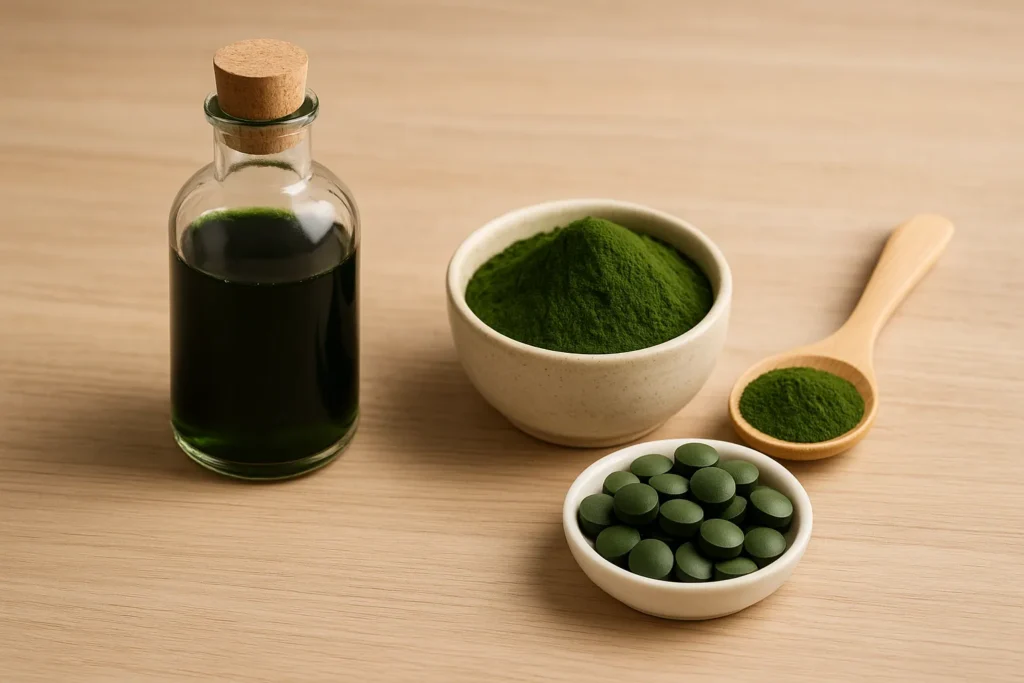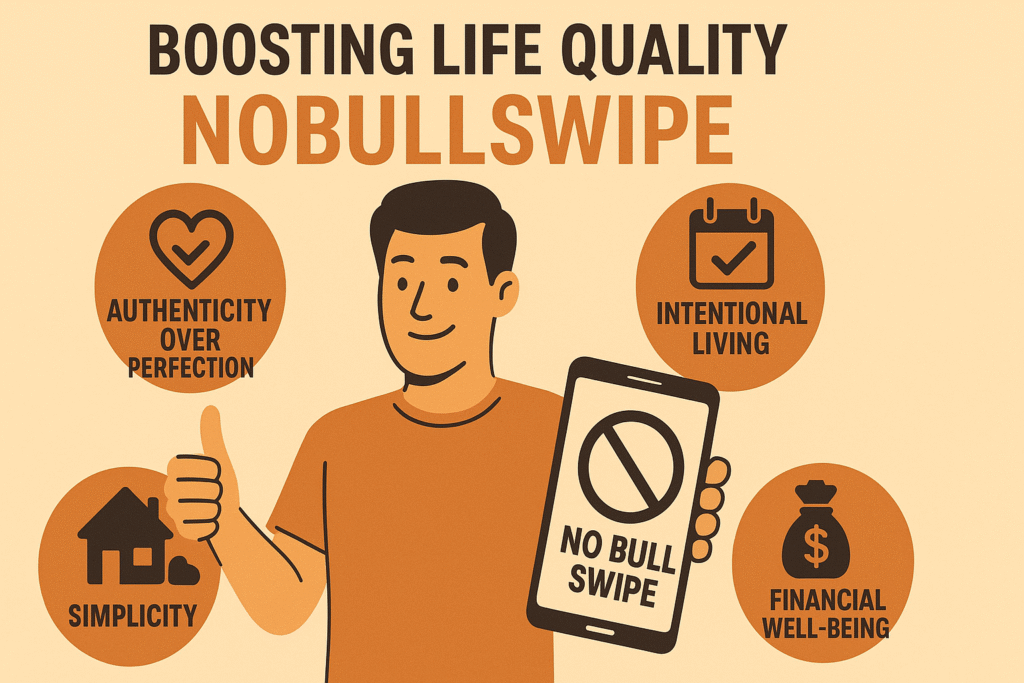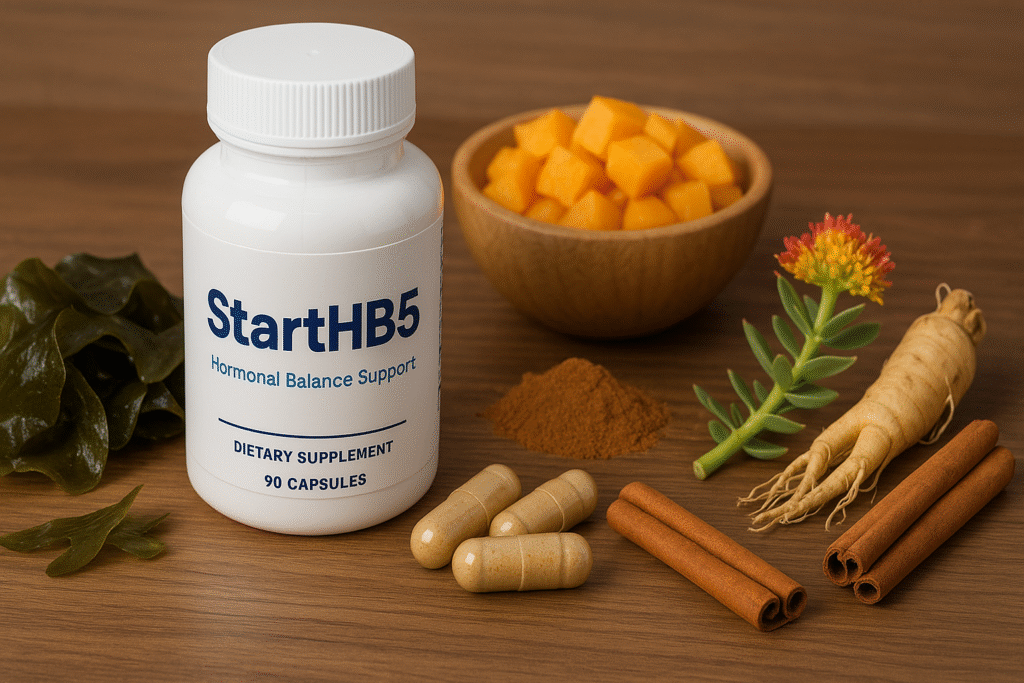If you’ve ever strolled through a health store or scrolled wellness TikTok, you’ve probably seen “chlorophyll drops” and “chlorella powder” popping up everywhere. At first glance, they look almost the same — both are green, both are linked to detox and skin benefits, and both sound like something straight out of a science textbook. But here’s the thing: chlorophyll and chlorella aren’t actually the same at all.
Chlorophyll is a compound, the natural green pigment found in plants that helps them absorb sunlight. Chlorella, on the other hand, is a whole algae organism that happens to be loaded with chlorophyll — plus tons of other nutrients. Think of it this way: chlorophyll is an ingredient, while chlorella is a complete meal.
In this guide, we’ll break down the differences, benefits, and real-world uses of both. Whether you’re curious about detox, body odor hacks, or just figuring out which supplement is worth your money, this article will help clear things up.
Snippet-Ready Definition:
Chlorophyll vs chlorella: Chlorophyll is a natural green pigment that supports detox, skin, and odor, while chlorella is a nutrient-rich algae containing chlorophyll plus protein, vitamins, and minerals for overall health.
What is Chlorophyll?
Chlorophyll is nature’s green pigment — the stuff that makes leaves, spinach, and broccoli look so vibrant. In plants, it’s essential for photosynthesis, the process that converts sunlight into energy. For humans, though, chlorophyll has become popular for a totally different set of reasons.
In supplement form, you’ll often see liquid chlorophyll drops or capsules. These are usually not “pure chlorophyll” but a semi-synthetic derivative called chlorophyllin, which is easier for the body to absorb. People take it for benefits ranging from fresher breath to improved digestion, and even as a skin-boosting hack.
Here’s the best part: chlorophyll is found naturally in foods you already eat. Leafy greens like spinach, kale, and parsley are loaded with it. Seaweed and certain algae are rich sources too. So technically, if you’re eating a diet high in greens, you’re already consuming plenty of chlorophyll without needing a dropper bottle.
What is Chlorella?
Now let’s talk about chlorella. Unlike chlorophyll, which is just a pigment, chlorella is an actual single-celled green algae that’s been around for billions of years. It grows in freshwater and has earned a reputation as one of the most nutrient-dense “superfoods” out there.
Here’s what makes chlorella so powerful:
- It’s rich in protein (over 50% of its dry weight).
- It contains essential vitamins like B12, vitamin C, and vitamin E.
- It’s a source of minerals such as iron, magnesium, and zinc.
- And yes — it’s packed with chlorophyll too.
Because its cell walls are tough to digest, chlorella sold as a supplement is usually “broken cell wall chlorella.” You’ll find it in powders, tablets, and capsules. Wellness enthusiasts love it for detox cleanses, boosting energy, and even supporting immune function.
If chlorophyll is like taking a single key nutrient, chlorella is like taking a whole multivitamin made by nature. It offers the pigment benefits of chlorophyll plus a wide spectrum of nutrients your body can actually use for daily health.
Chlorophyll vs Chlorella: Key Differences
At this point, you might be wondering — okay, they both sound healthy, but what’s the real difference? Here’s the simplest way to put it:
- Chlorophyll = a pigment (a single compound).
- Chlorella = a whole algae (a complete organism with many nutrients, including chlorophyll).
Think of chlorophyll as vitamin C, and chlorella as the orange. One is an isolated nutrient, while the other is a natural food that contains it along with a bunch of other goodies.
Another important difference is how your body processes them. Chlorophyll, especially when taken as liquid chlorophyll drops, is quickly absorbed. Chlorella, on the other hand, takes a little more work because of its tough cell wall, which is why supplements use “broken cell wall chlorella” for better absorption.
In short: if you want a quick chlorophyll boost, drops or capsules may do the trick. If you want a nutrient-dense superfood, chlorella is the way to go.
Shared Benefits of Chlorophyll and Chlorella
Even though they’re different, chlorophyll and chlorella share a few overlapping benefits. This is where people often get them mixed up.
- Detox support: Both are linked to cleansing effects, especially with toxins and heavy metals. While the science is still ongoing, many people swear by them for gut and liver health.
- Antioxidant protection: They help neutralize free radicals, which may reduce oxidative stress and support overall cellular health.
- Skin and body odor: Here’s the thing — liquid chlorophyll has a reputation for improving body odor, while chlorella fans believe it helps their skin look clearer and healthier. Either way, both have “beauty from within” potential.
- Liver support: Both may help the liver do its job more efficiently, which makes sense since the liver is your body’s natural detox organ.
So yes, there’s overlap, but the depth of nutrients in chlorella makes it more of a whole-food supplement, while chlorophyll tends to be more of a focused aid.
Unique Benefits of Chlorophyll
Chlorophyll has a few benefits that chlorella can’t match quite as directly.
- Body odor and breath freshness: This is the claim that made chlorophyll drops go viral on TikTok. While more research is needed, some early studies and plenty of anecdotal stories suggest chlorophyll may help reduce bad breath and even body odor.
- Skin support: Some people use chlorophyll internally or topically (in masks and serums) for reducing acne or redness. It’s thought to help oxygenate the skin and promote healing.
- Detox light: While chlorella is the heavyweight in detox, chlorophyll still plays a supporting role in binding some toxins and promoting gut health.
Personal tip: If you’re curious but don’t want to commit to powders or tablets, try adding a few drops of liquid chlorophyll to your morning water. It’s an easy experiment, and you’ll know within a week or two if it makes a difference for you.
Unique Benefits of Chlorella
Chlorella’s benefits stretch far beyond what chlorophyll can offer. Because it’s a whole algae, it acts more like a complete superfood.
- Nutrient powerhouse: Chlorella is rich in protein, vitamin B12 (rare in plant sources), iron, omega-3s, and antioxidants. For people eating mostly plant-based diets, this is a big win.
- Heavy metal detox: Research suggests chlorella can help bind heavy metals like lead or mercury and assist the body in flushing them out. This makes it popular in detox protocols.
- Immune support: Regular chlorella intake may support immune system function. Some studies show it may boost antibodies and natural killer cell activity.
- Skin glow: Many people notice better skin tone and texture when they use chlorella regularly. The combo of chlorophyll plus antioxidants is likely why.
Guess what? Chlorella isn’t just for detox junkies — athletes use it for recovery, and wellness fans love it as a smoothie booster. It’s surprisingly versatile.
Comparing Chlorophyll, Chlorella, and Spirulina
Here’s where it gets even more interesting: people often bring spirulina into the mix. Spirulina is another blue-green algae that shares the superfood spotlight with chlorella. So how do they all stack up?
- Chlorophyll vs chlorella vs spirulina: Chlorophyll is a pigment, chlorella is a green algae rich in chlorophyll, and spirulina is a blue-green algae rich in protein and phycocyanin (another pigment).
- Spirulina vs chlorella: Spirulina usually wins on protein content and digestibility, while chlorella offers more chlorophyll and detox potential.
- Chlorophyll vs spirulina: Chlorophyll is just a pigment, while spirulina is a whole-food source with multiple nutrients.
The best part is that you don’t necessarily have to choose. Many supplements combine chlorella and spirulina for a more balanced nutrient profile, and you can still add chlorophyll drops separately if you’re curious about its unique perks.
How to Choose the Right Option for You
Here’s the truth: there’s no one-size-fits-all answer. Chlorophyll and chlorella serve different purposes, and the better choice depends on your goals.
- When to choose chlorophyll: If you’re mainly curious about body odor hacks, fresher breath, or light detox, liquid chlorophyll drops might be a quick, affordable start. They’re easy to add to water and don’t need much prep.
- When to choose chlorella: If you want a more complete nutritional boost — especially for plant-based diets — chlorella is your friend. It’s loaded with protein, vitamins, minerals, and antioxidants. Think of it as a daily nutrient booster.
- Can I take chlorella and chlorophyll together? Absolutely. Since chlorella already contains chlorophyll, combining both isn’t harmful. In fact, some people use drops during the day for quick support and chlorella tablets for long-term health.
Here’s a simple comparison table:
| Goal | Better Option | Why |
| Body odor / fresher breath | Chlorophyll | Directly studied for deodorizing properties |
| Skin glow | Both | Chlorophyll supports healing, chlorella provides nutrients |
| Detox (heavy metals, toxins) | Chlorella | Strong evidence for binding heavy metals |
| Nutrition boost | Chlorella | Packed with vitamins, minerals, protein |
| Easy daily routine | Chlorophyll drops | Quick to mix with water |
Science-Backed Insights and Expert Opinions
Here’s the thing: supplements often get hyped online, but it’s important to check the research.
- Chlorophyll: Some studies suggest chlorophyllin (the supplement form) may help with body odor, gut health, and even reduce the risk of certain toxins binding to DNA. But the research is still limited, and more human trials are needed.
- Chlorella: There’s stronger evidence here. Clinical studies have found that chlorella can help reduce heavy-metal levels in the body, support immune function, and even lower cholesterol in some cases. For example, a study published in Nutrition Journal showed improvements in blood pressure and cholesterol markers after chlorella supplementation.
- Spirulina comparison: Spirulina also has a lot of research backing its immune-boosting and anti-inflammatory effects. Pairing it with chlorella may cover more health bases.
Expert advice usually sounds like this: chlorophyll drops are safe to try, but if you’re after comprehensive health benefits, chlorella (and sometimes spirulina) is the smarter long-term choice.
Safety, Dosage, and Practical Considerations
Whenever you add supplements to your routine, safety matters.
- Chlorophyll dosage: Liquid chlorophyll drops often recommend 50–100 mg per day, but follow the label. Some people start with just a few drops in water to test tolerance.
- Chlorella dosage: Most brands suggest 2–3 grams daily, often in tablet form. You can also add powder to smoothies, but the taste can be a little grassy.
- Safety notes:
- Both are generally considered safe.
- Chlorella can sometimes cause digestive upset (gas, bloating) when you first start.
- Because chlorella binds heavy metals, it’s especially important to buy from a reputable brand that tests for purity.
- If you’re pregnant, breastfeeding, or on medication, talk with your doctor first.
Pro tip: Always look for third-party tested supplements. That’s the easiest way to avoid contamination issues, especially with algae products.
Real-World Tips and Personal Experience-Style Advice
Let’s get practical. How do you actually make these a part of your life without feeling overwhelmed?
- For chlorophyll: Add drops to a big glass of water first thing in the morning. Some people say it helps them start the day hydrated and energized. Don’t be surprised if your tongue or… bathroom visits look a little greener — that’s normal.
- For chlorella: If you don’t love grassy flavors, tablets are your best bet. I’ve tried mixing powder into smoothies, and while it’s not bad, the taste is definitely “earthy.” Pairing it with pineapple or citrus helps mask it.
- Consistency matters: Neither chlorophyll nor chlorella is a magic bullet. You’ll need to use them consistently for a few weeks to notice changes in skin, energy, or digestion.
- Set realistic expectations: Chlorophyll probably won’t turn you into a glowing goddess overnight, and chlorella won’t single-handedly detox your body. But together with a healthy diet, they can absolutely support your wellness journey.
On top of that, many people online (especially on Reddit forums) share that their biggest wins came from pairing chlorella or chlorophyll with lifestyle basics — better sleep, exercise, and hydration. Supplements work best when you cover those foundations first.
Cultural, Environmental, and Future Perspectives
Chlorella and chlorophyll aren’t just modern supplement trends — they’ve got interesting cultural and environmental backstories.
- History of chlorella: After World War II, scientists studied chlorella as a possible solution for world hunger because it grows fast and is packed with protein. While it never became a staple food, it earned a reputation as a future-friendly food source.
- Chlorophyll in traditional healing: While chlorophyll itself wasn’t isolated until the early 1800s, green plants and herbs rich in chlorophyll have been central in traditional medicine systems for centuries. Think wheatgrass shots, herbal tonics, and green leafy diets.
- Sustainability angle: Algae like chlorella and spirulina are considered eco-friendly crops. They require less land and water compared to animal protein and can even help absorb carbon dioxide. So, choosing chlorella supplements may actually be a small step toward a more sustainable diet.
- Future research: Scientists are exploring new uses of chlorophyll derivatives in cancer prevention, wound healing, and even as natural food colorants. Algae biotechnology is also growing, with research into how chlorella and spirulina can help fight climate change while feeding more people.
Community Insights and FAQs (Including Reddit Discussions)
If you browse wellness communities, especially places like Reddit, you’ll notice people debating “chlorophyll vs chlorella” passionately. Here are some common questions and what most folks (and experts) say:
- Is chlorophyll or chlorella better for detox?
Most users agree chlorella is more effective for heavy-metal detox because of its nutrient profile and binding properties. Chlorophyll helps but is lighter in effect. - Which is better for skin?
Both can help. Chlorophyll may reduce acne and redness, while chlorella nourishes skin from within thanks to vitamins, minerals, and antioxidants. - Can I take chlorella, chlorophyll, and spirulina together?
Yes. Many people stack them. Chlorella and spirulina make a nutrient powerhouse, and chlorophyll drops are easy to sip daily. - Are they worth the money?
It depends. If you’re already eating a nutrient-rich diet, you may not need them. But if you’re curious about detox, plant-based nutrition, or skin benefits, they’re worth experimenting with. Just remember: quality matters more than quantity.
Community tip: A lot of users recommend starting slowly with chlorella because it can cause bloating at first. With chlorophyll drops, start with half a dose to see how your body reacts.
Comparison Table
| Aspect | Chlorophyll | Chlorella |
| What it is | A green plant pigment (compound) | A single-celled green algae (organism) |
| Key nutrients | Chlorophyll only | Chlorophyll + protein, B12, iron, antioxidants |
| Benefits | Supports skin, odor control, light detox | Strong detox, nutrient boost, immune support |
| Best for | Quick daily support | Comprehensive nutrition & heavy-metal detox |
| Form | Drops, capsules, liquids | Powders, tablets, capsules |
Bullet List: Quick Takeaways
- Chlorophyll = pigment, chlorella = algae superfood.
- Chlorophyll works fast for odor, skin, and detox light.
- Chlorella provides protein, vitamins, minerals, and stronger detox effects.
- You can safely take both together.
- Choose based on your goals: quick support vs nutrient powerhouse.
Conclusion
So, what’s the final verdict in the chlorophyll vs chlorella debate?
Here’s the thing: they’re related but not interchangeable. Chlorophyll is a simple compound that’s great for body odor, light detox, and skin support. Chlorella is a full-blown superfood algae that delivers protein, vitamins, minerals, and detox power all in one.
- Want quick wins for breath freshness or clear skin? Chlorophyll drops might be your go-to.
- Looking for long-term health support, especially if you’re plant-based? Chlorella makes more sense.
- And if you’re still on the fence, you don’t have to pick sides. Many people use both — or even combine them with spirulina — for a more complete wellness routine.
At the end of the day, supplements should complement your lifestyle, not replace it. Eat your greens, stay hydrated, move your body, and sleep well. Then, if y
FAQs
Can I take chlorophyll and chlorella together?
Yes. They’re safe to combine. Chlorella naturally contains chlorophyll, and adding drops or capsules alongside it won’t cause harm. Many people stack them for broader benefits.
What are the downsides of chlorella?
Some people experience digestive upset (gas, bloating) when starting chlorella. It can also interact with medications like blood thinners. Always choose third-party tested brands to avoid contamination.
Is chlorophyll good for pregnancy?
While chlorophyll from natural foods is safe, supplements haven’t been studied enough for pregnancy. It’s best to consult your doctor before adding chlorophyll drops or capsules during pregnancy.
What toxins does chlorella remove?
Research shows chlorella may help bind and flush out heavy metals like mercury, lead, and cadmium. It’s also studied for supporting the removal of certain dioxins and chemical pollutants.
Is chlorella better than spirulina?
It depends. Chlorella has more chlorophyll and detox potential, while spirulina is richer in protein and easy to digest. Many people take both together for a balanced boost.
Disclaimer
This article is for informational purposes only and does not provide medical advice. Chlorophyll, chlorella, or any supplement should not replace a balanced diet, medical treatment, or professional care. Always consult a qualified healthcare provider before starting new supplements, especially if you are pregnant, breastfeeding, or taking medication.

Hi, I’m Bilal, the founder of outofmagazine.com. I love sharing fresh ideas, stories, and helpful insights on all kinds of topics that spark curiosity. My goal with this site is simple—to create a space where readers can find inspiration, useful tips, and engaging reads on lifestyle, trends, and everything in between.



